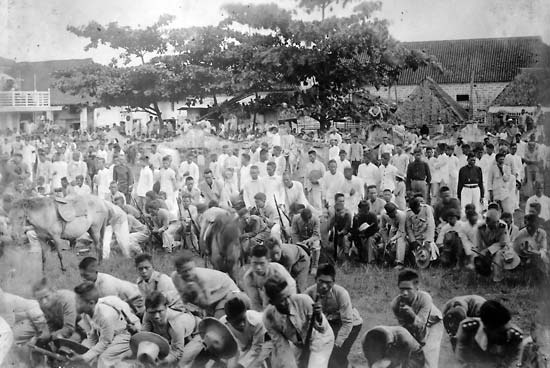Philippine-American War
Filipino history
 a war between the United States and Filipino revolutionaries from 1899 to 1902; the insurrection may be seen as a continuation of the Philippine Revolution against Spanish rule. The Treaty of Paris (Paris, Treaty of) (1898) transferred Philippine sovereignty from Spain to the United States but was not recognized by Filipino leaders, whose troops were in actual control of the entire archipelago except the capital city of Manila. Although an end to the insurrection was declared in 1902, sporadic fighting continued for several years thereafter.
a war between the United States and Filipino revolutionaries from 1899 to 1902; the insurrection may be seen as a continuation of the Philippine Revolution against Spanish rule. The Treaty of Paris (Paris, Treaty of) (1898) transferred Philippine sovereignty from Spain to the United States but was not recognized by Filipino leaders, whose troops were in actual control of the entire archipelago except the capital city of Manila. Although an end to the insurrection was declared in 1902, sporadic fighting continued for several years thereafter.Commodore George Dewey (Dewey, George) defeated the Spanish fleet in Manila Bay on the morning of May 1, 1898, but could not occupy Manila until ground troops arrived three months later. On August 13 Manila fell after a bloodless “battle.” Spanish Governor Fermín Jáudenes had secretly arranged a surrender after a mock show of resistance to salvage his honour. With American troops in possession of the city and Filipino insurgents controlling the rest of the country, conflict was inevitable.
The war began with shooting on the outskirts of Manila on the night of Feb. 4, 1899. Throughout the spring of 1899, American troops pushed north into the central Luzon Plain, and by the end of that year the Filipino general Emilio Aguinaldo retreated into the inaccessible northern mountains. The period of conventional battles ended, but insurgent leaders in many provinces continued bitter guerrilla warfare.
Fighting flared with increased bitterness on the island of Samar in 1901. General Jacob F. Smith, enraged by a guerrilla massacre of U.S. troops, launched a retaliatory campaign of such indiscriminate ferocity that he was court-martialed and forced to retire.
After 1902 the American civil government regarded the remaining guerrillas as mere bandits, though the fighting continued. About 1,000 guerrillas under Simeón Ola were not defeated until late 1903, and in Batangas province, south of Manila, troops commanded by Macario Sakay resisted capture until as late as 1906.
The last organized resistance to U.S. power took place on Samar from 1904 to 1906. There, the rebels' tactic of burning pacified villages contributed to their own defeat. The United States gained an undisputed control of the Philippines and retained possession of the islands until 1946.
- Gombrowicz, Witold
- Gomes, Diogo
- Gompers, Samuel
- Gomperz, Theodor
- Gomułka, Władysław
- gonad
- Gonaïves
- Goncharova, Natalya
- Goncharov, Ivan Aleksandrovich
- Goncourt, Edmond and Jules
- Gond
- Gonda
- Gonder
- Gondi Family
- Gondi language
- gondola
- Gondomar, Diego Sarmiento de Acuña, Count de
- Gondophernes
- Gondwana
- gonfalonier
- gong
- gongbi
- Gongola River
- Gong Qinwang
- Gongsun Hong